UiPath 2022.6 Monthly Update

It's June, and for those of us in the northern hemisphere that means the beginning of summer. The sun has even been spotted here in Seattle! June also marks the first public milestone, the 2022.6 release, on the road to our 2022.10 release (which we will highlight at our forthcoming FORWARD 5 event). This month, we have lots to share about the first set of capabilities headlining into preview and availability in UiPath Automation Cloud™.
Let’s start with one of our key offerings in the discover area: UiPath Process Mining.
UiPath Process Mining
In 2022.6, Process Mining capabilities mature to enable further process optimization and actionability. We are releasing capabilities that accelerate time to value, particularly the experience of building Process Mining apps for developers. Additionally, enhanced data editing and analysis capabilities help generate deeper insights for process analysts.
TemplateOne
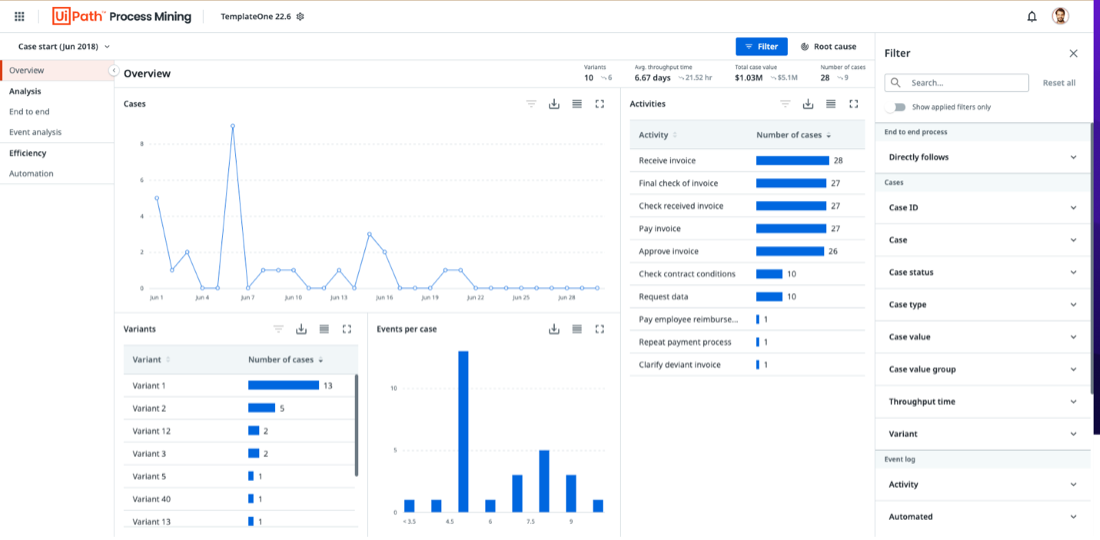
It all begins with TemplateOne, which enhances the experience for UiPath Process Mining users. TemplateOne is a ready-to-use process mining app template offering a pre-built set of dashboards and visualizations, enabling analysis of any process. With this template, users can load any process data from their systems. The template kickstarts the discovery experience and understanding by providing generic, out-of-the-box visualizations.
Application editing
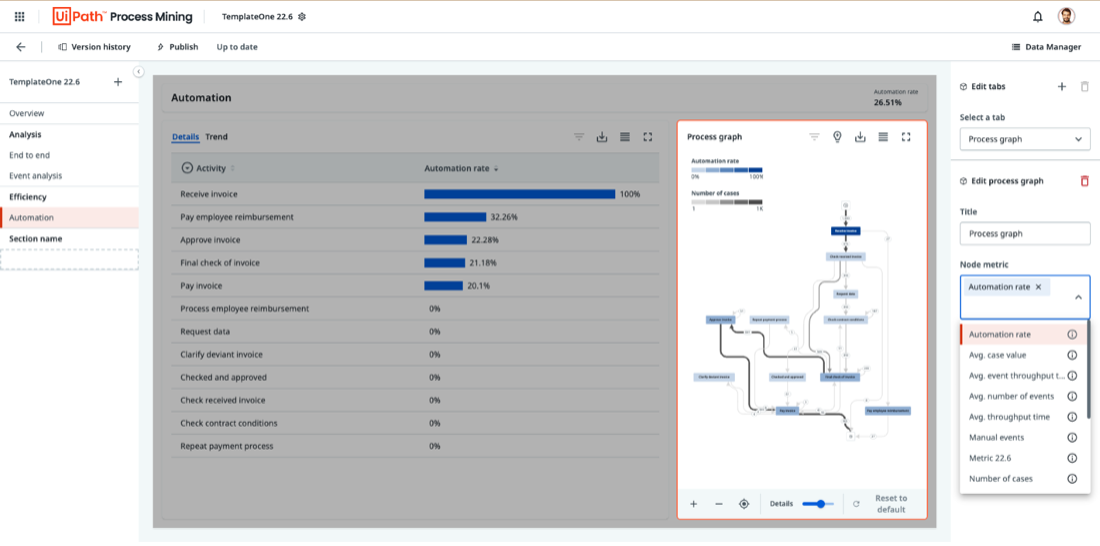
With the new application editing experience in UiPath Process Mining, users analyzing a business process can tailor the dashboard. With a tailored dashboard they gain insights across key performance indicators (KPIs), variants, and metrics they are most interested in.
The 2022.6 release includes a set of features which allows customizations of Process Mining apps. Pick a visual component on a dashboard, edit, remove, or add new sections to meet your requirements. Edit which process data fields you want to expose in your app and enrich the insights gained from your dashboards. Users have complete control and can:
Edit fields of their process data
Remove data from being visible
Add completely custom new metrics
Additionally, you can configure the aggregation method of your dashboards and version control on the changes made to your Process Mining apps.
Root cause analysis
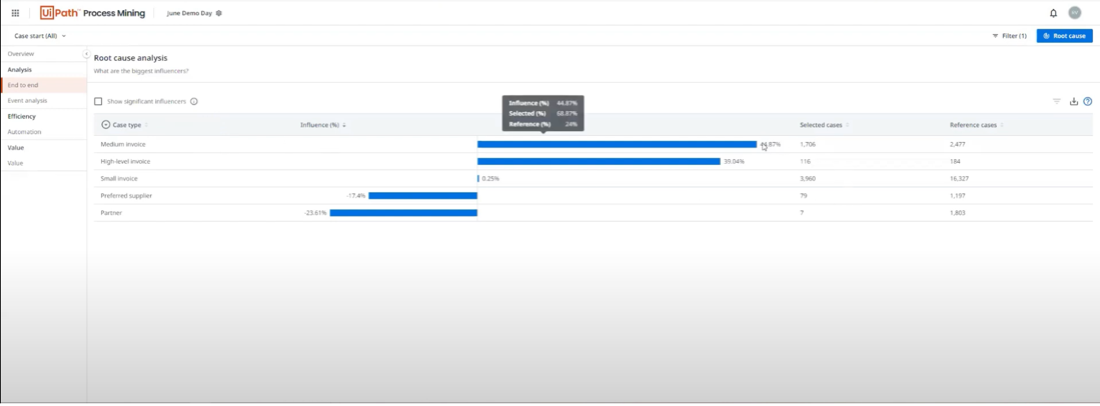
This month, the 2022.6 release brings root cause analysis to Process Mining in Automation Cloud™. With root cause analysis, domain experts can uncover significant data influences for specific process situations. Analysts seeking optimization opportunities can use root cause analysis to compare the influence of specific record/case properties on selected KPIs across a process or within a reference set of cases.
Moving to the build part of the automation lifecycle, we have improvements across the board.
UiPath Integration Service
We continue to rapidly evolve UiPath Integration Service ensuring you have the best of user interface (UI)- and API-based approaches to automation. In 2022.6, we have added new connectors and improved our Triggers with Data Filters. First, let’s look at the new connectors and what they enable you to automate.
New connectivity with Adobe
UiPath recently announced new integrations with our partner, Adobe. The two companies now provide Adobe customers the opportunity to reduce the time and effort it takes to scale and deliver accurate and intelligent document workflows.
The partnership incorporates newly released, prebuilt, UiPath integration connectors, designed to directly connect with the Adobe PDF Services API, including:
Adobe PDF Services
Adobe Document Generation
UiPath Activity Pack for Acrobat Sign
For more specifics, read our recent blog post New Adobe Connectors Accelerate Document Processing Automation.
Four updated Activity Packs deliver expanded use cases
New BambooHR activities benefit both robotic process automation (RPA) and citizen developers who want to easily automate creation and management of employee records. Upgraded to .NET6, newly curated activities have been added:
Create employee (basic)
Update employee (basic)
Search employee’s directory
A drop-down is now available to enable quick employee searches:
Get employee
Update employee (basic)
Twilio activities have also been upgraded to .NET6. In fact, the latest refinement of Twilio activities increases its automation synergies with BambooHR, such as contacting application candidates with SMS, iPhone, and WhatsApp.
GoToWebinar and Cisco Webex Teams activities enable use cases such as this registrant-to-lead workflow:
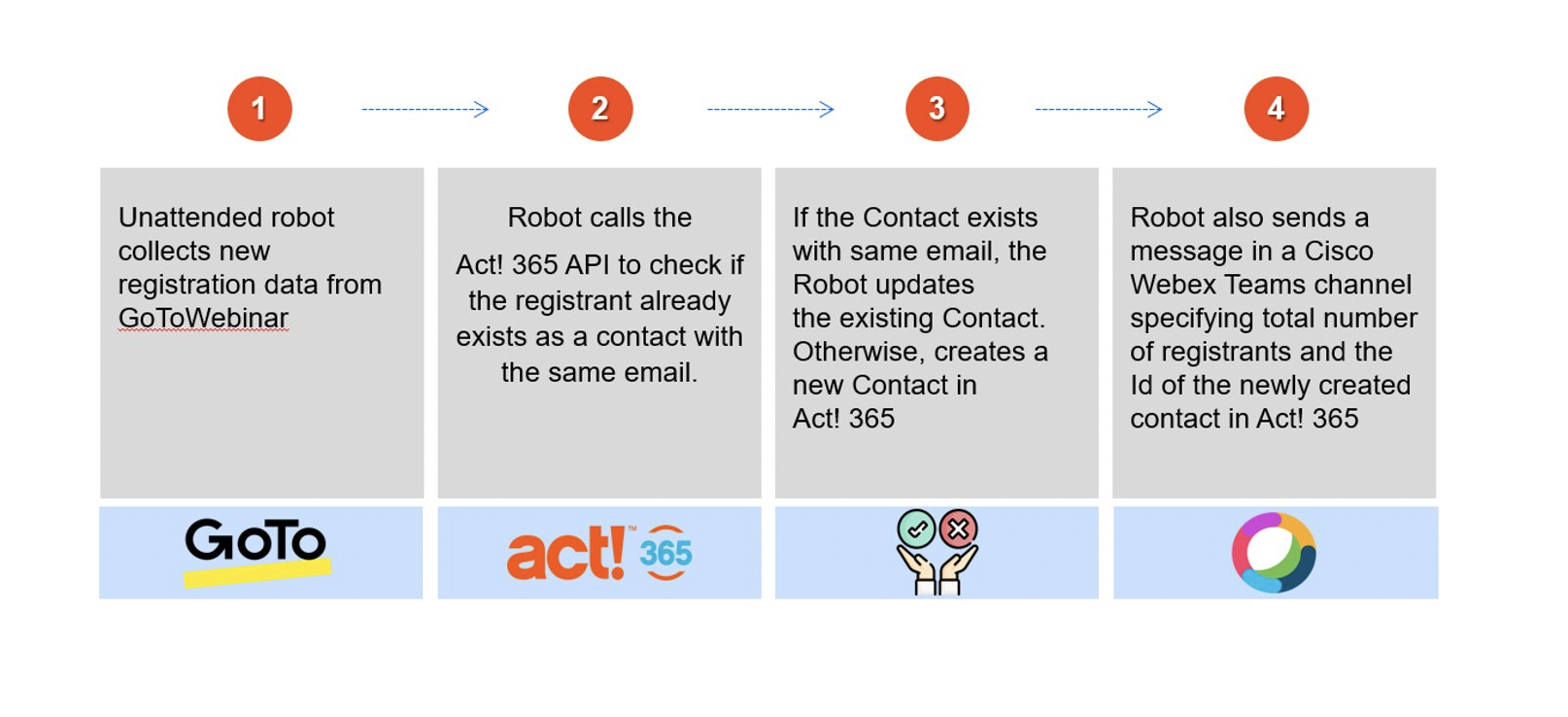
Both connectors provide a design time and run time that allows users to select via the Configure Connection Wizard. This new functionality also allows selection from the drop-down, connection menu in UiPath Studio (design time), as well as the connection for the desired robot run time.
As with the Adobe connector, all new integrations are available through the Integration Service Connector Catalog.
Trigger data filters
Triggers were a key capability we delivered in 2021.10. In 2022.6, we are enhancing them with support for data filters.
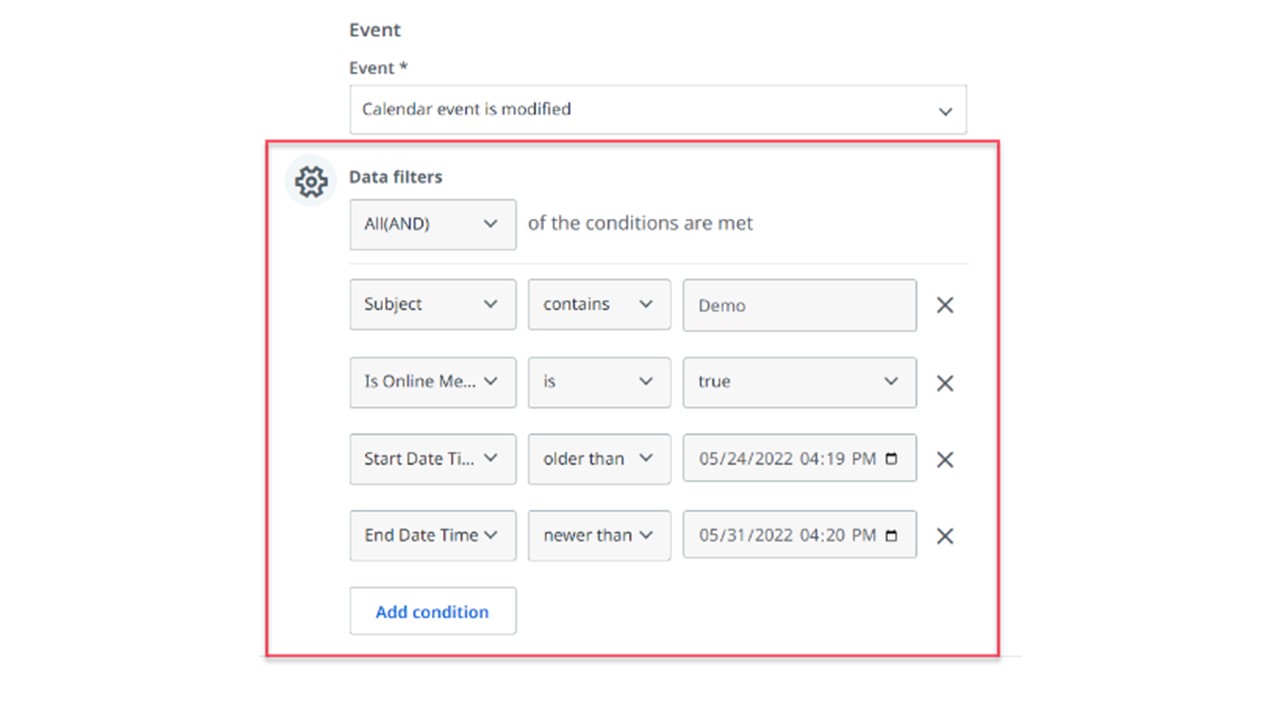
Event triggers can now be refined by filtering down on specific criteria. For example, a filter can determine automatic updates once the status of a Salesforce opportunity changes to 'Closed Won'. Or a calendar event will only trigger a next step based on specific conditions, e.g., time criteria, subject, and so on.
Rich Text Editor in UiPath Apps
UiPath Apps is the easiest way for automation developers to build user experience (UX)-friendly interfaces for automations. We have been very focused on adding additional capabilities based directly on your feedback. This month, we’ve addressed one of the top requests: now you can offer rich text editing capabilities for your users with the Rich Text Editor control.

UiPath Marketplace: business solutions deep dive
One of the important areas that spans the automation lifecycle is our Marketplace. In a 2022.4 blog post, we shared exciting news about UiPath Marketplace enriching its catalog of prebuilt automations with business solutions. Since then, UiPath Business and Technology Partners have contributed more than a dozen supported automation solutions that solve diverse business challenges. Starting with 2022.6, we will be introducing you to one Marketplace business solution each month, including its capabilities and the benefits it brings to your business.
The business solution we’re featuring this month is Oracle Bot-Builder. Developed by UiPath Technology Partner AuraPlayer, this solution is designed specifically for Oracle applications. Oracle Bot-Builder works with Oracle components on the server side, making it resistant to UI changes, Oracle E-Business Suite (EBS) patches, unexpected pop-ups, and error messages.
Oracle Bot-Builder plugs directly into the UiPath Studio menu bar and allows importing Oracle workflows into UiPath as sequences. Thanks to this AuraPlayer’s business solution, you can easily create stable automations for any process within Oracle Forms/EBS. Make sure to check it out on UiPath Marketplace.
New Insights dashboard template: Attended Reporting
UiPath Insights comes with a library of dashboard templates that make it quick and easy to track and analyze the performance of your automation program. This template library is an area we are constantly looking to update and expand.
In the 2022.6 release, we are excited to share a new template, specifically for citizen development and attended automation, that we've recently published for our Automation Cloud customers (and coming in 2022.10 to our self-hosting customers).
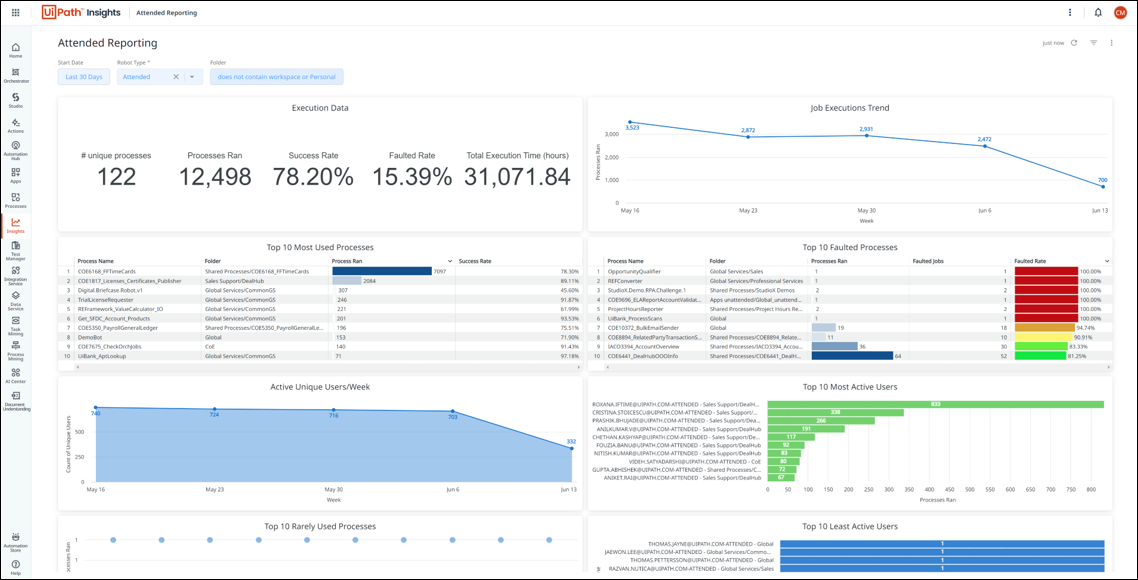
The Attended Reporting dashboard template includes metrics focused on attended automations, including Execution Trends, Most and Least Active Users, and the Most Used and Most Faulted Processes. These metrics will help provide an increased level of awareness over where your attended automations are excelling, which could use some help, and which members of your robotic operating team are most active.
And just like all of the Insights dashboard templates, it can be quickly copied, customized and shared—to the users on your tenant, or to additional stakeholders via email or image export. For more information on Attended Reporting, or to view the full list of over 20 metrics included in this template, please refer to the Insights Attended Reporting docs page.
A fresh look and new UI improvements for UiPath Studio
With a clean header design and new colors support, the new look of our activities available for all projects starting with 2022.6 release promises to bring a fresh image to UiPath Studio. But looks are not everything. So, for the last few months, the team has been working hard to bring in a unified declarative language for all UI activities, based on manifest files and input types. This will generate the UI of any application unified across all Studio activities, with dedicated controls for most common inputs: text builder, number, dates, etc.
Building on this new unified language, we are expanding the capabilities of Studio libraries with support for defining display names. This is important, especially when working with business users, so we are also adding support for colors and icon definitions. The definitions can be controlled at the activity level and allow even more personalization.
Following a successful implementation in UiPath StudioX, we are bringing more and more elements back into the Studio interface. With this release, it is Data Manager, which will replace and improve some of the legacy panels in Studio. Data Manager becomes a one-stop shop for variables, app cards, arguments, and a lot more. And that’s just the beginning of this new feature. We plan for Data Manager to become your one-stop shop for resources.
New data retention and archiving policies in Automation Cloud Orchestrator
Soon, we'll implement new data retention and archiving policies in Automation Cloud Orchestrator. These will change how long existing and new queue items in a final state are retained. You'll also have new options to configure data retention policies at queue level in Orchestrator to handle automatic archiving or deletion for finished transactions. This gives you the benefit of increased data compliance, and better performance due to reduced active transaction footprint.
With these new policies, all the queues and the corresponding queue items in your tenant will be mapped to a data retention policy—either the default one or a custom policy you define. In the default policy, migrated queue items will be stored for 120 days after they were last modified and new queue items for 30 days, then deleted permanently. However, you can define your own custom policies to change this.
Policies only apply to items in a final state, and the reference date for queue items is the last modified date. If our default policy does the trick for you, then you’re all set. If you have different requirements, you can extend the retention duration to a maximum of 180 days, and choose whether you then want to delete or archive queue items. If you want to archive historical queue items and keep them after implementation, you need to take action and configure your own policies. Configuration is easy to do via the UI or through a new API. It’s also worth noting that UiPath Insights functionality will not be affected—information about removed queue items will still be shown.
To learn more about this and keep track of feature availability, we recommend you read the related docs.
As you can see, the team has been very busy and there was a lot to cover this month! I invite you to try all the new capabilities and keep the feedback coming through the Insider program.

Advisor to the Co-CEOs, UiPath
Get articles from automation experts in your inbox
SubscribeGet articles from automation experts in your inbox
Sign up today and we'll email you the newest articles every week.
Thank you for subscribing!
Thank you for subscribing! Each week, we'll send the best automation blog posts straight to your inbox.



